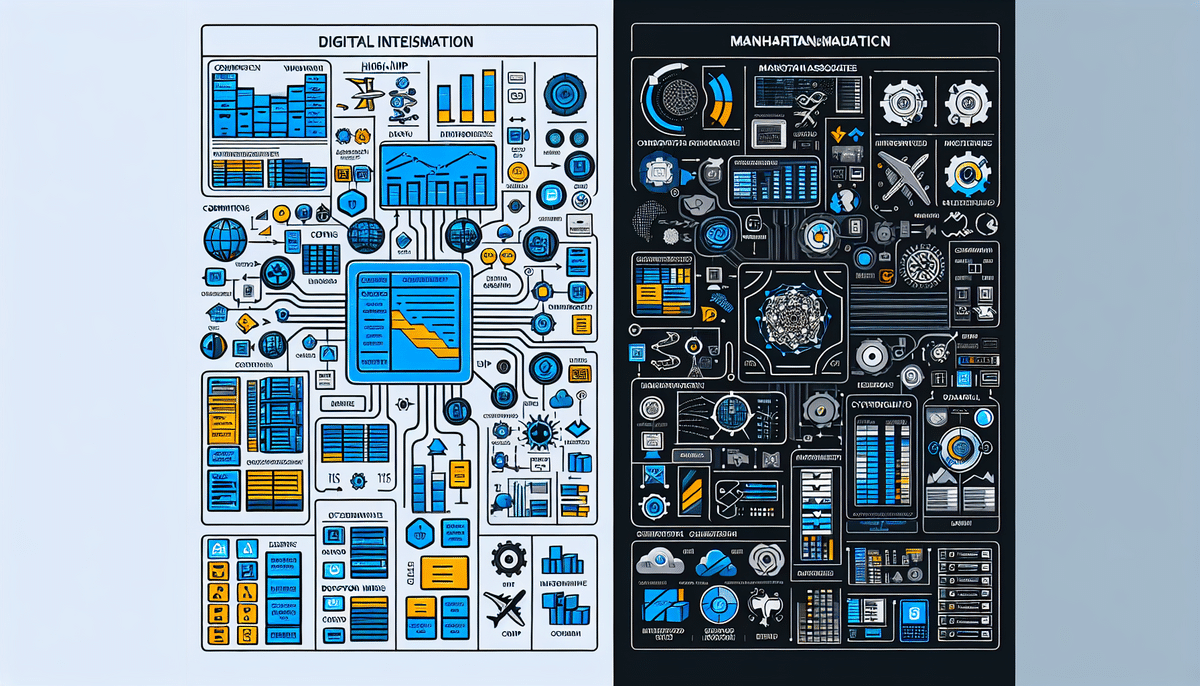Introduction to Warehouse Management Systems (WMS)
Warehouse Management Systems (WMS) are essential components of modern supply chain operations, enabling companies to efficiently manage and optimize inventory, orders, and shipments across multiple facilities. With the increasing complexity of logistics and the ongoing digital transformation of the industry, businesses are increasingly adopting WMS solutions to gain enhanced visibility and control over their operations.
Overview of Manhattan Associates WMS and HighJump WMS
Manhattan Associates WMS
Manhattan Associates is a leading provider of supply chain software solutions, including Warehouse Management Systems (WMS). Their WMS offering is designed to streamline warehouse operations, enhance inventory accuracy, and optimize order fulfillment processes. Key features include labor management, slotting optimization, and robust integration capabilities with other supply chain systems.
HighJump WMS (now part of Körber)
HighJump, now part of Körber, is another prominent provider of logistics and supply chain software solutions, including robust Warehouse Management Systems. HighJump WMS offers a comprehensive suite of features such as receiving, putaway, inventory management, and shipping, with a strong emphasis on customizability and configurability to meet diverse business needs.
Key Features and Functionality
Manhattan Associates WMS
- Inventory Management: Enables real-time tracking and management of inventory levels, locations, and movements.
- Order Fulfillment: Streamlines the picking, packing, and shipping processes, reducing errors and improving speed.
- Labor Management: Optimizes workforce allocation and productivity, reducing overtime and labor costs.
- Slotting Optimization: Enhances warehouse layout and product placement to maximize efficiency.
- Multi-Channel Fulfillment: Supports order fulfillment across various channels, including e-commerce, retail, and wholesale.
Additionally, Manhattan Associates WMS includes advanced reporting and analytics, providing actionable insights into warehouse operations to drive continuous improvement. According to a Gartner report, the adoption of advanced WMS features can lead to a 20% increase in operational efficiency.
HighJump WMS (now part of Körber)
- Receiving: Manages the receipt and inspection of incoming shipments, ensuring accuracy and timely processing.
- Putaway: Automates the storage of goods, optimizing space utilization and minimizing handling costs.
- Inventory Management: Offers real-time visibility into inventory levels and movements, reducing stockouts and optimizing stock levels.
- Order Management: Streamlines the order processing workflow from entry to shipping, minimizing errors and delays.
- Shipping: Automates shipping processes, including carrier selection, labeling, and tracking.
HighJump WMS also provides task management and advanced analytics, enabling businesses to manage warehouse operations effectively and make informed decisions based on real-time data. A study by APICS highlights that customizable WMS solutions like HighJump can reduce order processing times by up to 30%.
Pricing Comparison
Both Manhattan Associates WMS and HighJump WMS offer flexible pricing models that depend on factors such as business size, complexity, number of users, and required features. Generally, Manhattan Associates WMS tends to have a higher upfront cost due to its extensive range of features and scalability. HighJump WMS, on the other hand, often offers a more cost-effective solution with a streamlined implementation process. However, the total cost of ownership for each solution should consider not only the initial license fees but also ongoing maintenance, support, and upgrade costs.
According to industry benchmarks from Software Advice, the average cost for implementing a WMS can range from $75,000 for small businesses to over $300,000 for enterprise-level solutions.
Implementation Process
The implementation process for both Manhattan Associates WMS and HighJump WMS includes several stages such as project planning, system configuration, data migration, training, and go-live support. Manhattan Associates WMS typically requires a longer implementation timeline due to its complexity and high degree of customization, which suits larger organizations with intricate supply chain operations. HighJump WMS offers a more streamlined implementation process, often resulting in shorter deployment times and lower initial costs, making it an attractive option for smaller to mid-sized businesses.
A Forbes article emphasizes the importance of thorough planning and stakeholder engagement to ensure successful WMS implementation, regardless of the chosen provider.
Customer Support and User Experience
Both Manhattan Associates WMS and HighJump WMS prioritize customer support and user experience. Manhattan Associates provides 24/7 technical support with a dedicated team of experts, extensive training resources, and a robust user community. HighJump WMS offers responsive customer support with a focus on quick problem resolution, along with comprehensive training and online resources.
In terms of user experience, Manhattan Associates WMS is known for its user-friendly interface and intuitive design, while HighJump WMS offers a flexible and customizable user interface tailored to specific business needs. According to user reviews on Capterra, both systems receive high marks for their ease of use and support quality.
Pros and Cons
- Manhattan Associates WMS
- Pros:
- Extensive range of features and functionalities
- Highly flexible and scalable architecture
- User-friendly interface
- Cons:
- Higher upfront costs
- Longer implementation timelines
- Pros:
- HighJump WMS (now part of Körber)
- Pros:
- Highly customizable and configurable
- Comprehensive feature set for warehouse management
- Responsive customer support
- Cons:
- Less intuitive user interface
- Smaller market share compared to Manhattan Associates
- Pros:
Use Cases
Manhattan Associates WMS
Manhattan Associates WMS is ideal for large-scale businesses with complex warehouse operations, high order volumes, and multi-channel fulfillment needs. Industries such as retail, e-commerce, and third-party logistics (3PL) providers benefit from its advanced optimization tools and scalability. For example, major retailers have leveraged Manhattan Associates WMS to improve inventory accuracy and reduce order processing times.
HighJump WMS (now part of Körber)
HighJump WMS is best suited for small to mid-sized businesses or those with less complex warehouse operations. It is particularly beneficial for industries like manufacturing, distribution, and transportation that require highly configurable and specialized warehouse management solutions. Companies in these sectors have utilized HighJump WMS to enhance inventory visibility and streamline their logistics processes.
Final Verdict: Choosing Between Manhattan Associates WMS and HighJump WMS
Ultimately, the decision between Manhattan Associates WMS and HighJump WMS depends on a business’s specific needs, size, and operational complexity. Manhattan Associates WMS is better suited for larger, more complex organizations that require a comprehensive suite of features and high scalability. HighJump WMS, now part of Körber, is ideal for smaller to mid-sized businesses seeking a customizable and cost-effective warehouse management solution. Both systems are highly regarded in the industry and offer comprehensive sets of features and functionalities. A thorough analysis of business requirements, along with cost-benefit evaluations, should guide the final choice.






















